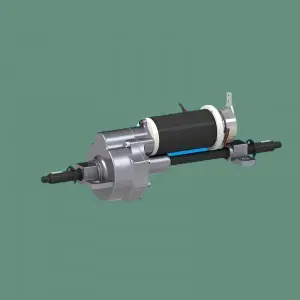If you want to upgrade your lawn tractor or small vehicle to a hydrostatic transmission, you may need to install a transaxle. A transaxle is a transmission and axle combination, typically used in vehicles with front-wheel drive or all-wheel drive systems. Installing a transaxle on a hydrostatic system can be a complicated process, but with the right tools and knowledge, it can be done efficiently. In this article, we will discuss the steps and considerations for installing a transaxle on a hydrostatic system.
Understand the components
Before starting the installation process, it is important to understand the components involved. A transaxle usually consists of a gearbox, differential and axle, all in one unit. Hydrostatic systems, on the other hand, use hydraulic power to control the speed and direction of the vehicle. When combining these two systems, it is critical to ensure that the transaxle is compatible with the hydrostatic system and that all components are properly aligned.
Select the appropriate transaxle
When selecting a transaxle for your hydrostatic system, consider factors such as the vehicle’s weight, horsepower, and intended use. It is critical to select a transaxle that can meet the power and torque requirements of a hydrostatic system. Also, make sure the transaxle is compatible with the vehicle’s frame and mounting points. Consulting a professional or referring to the vehicle’s specifications can help select the right transaxle for the job.
Prepare your vehicle
Before installing the transaxle, prepare the vehicle by removing the existing transmission and axle components. This may involve lifting the vehicle, draining fluids, and disconnecting the driveshaft and other related components. It is important to follow the manufacturer’s guidelines and safety precautions during this process. After removing the old parts, inspect the vehicle’s frame and mounting points to make sure they are in good condition and will fit the new transaxle.
Align transaxle
Proper alignment of the transaxle is critical to its performance and longevity. Make sure the transaxle is correctly positioned and securely mounted to the frame. Use the appropriate hardware and mounting brackets to secure the transaxle in place. Additionally, the transaxle input and output shafts are aligned with the hydrostatic system to ensure smooth power transfer and operation.
Connect the drive system
Once the transaxle is aligned and installed, it’s time to attach the driveline components. This may involve installing new axles, driveshafts and other related parts to connect the transaxle to the wheels and engine. Pay close attention to the alignment and installation of these components to prevent any problems with power transmission and vehicle operation.
Check fluid level and operation
After installing the transaxle and connecting the driveline components, it is important to check the fluid levels in the transaxle and hydrostatic systems. Be sure to use the correct type and amount of fluid specified by the manufacturer. After verifying the fluid level, start the vehicle and test the operation of the transaxle and hydrostatic system. Listen for any unusual noises and monitor the vehicle’s movements to make sure everything is running properly.
Test and adjust
Once installation is complete, test drive the vehicle in a safe and controlled environment. Pay attention to the vehicle’s acceleration, braking and turning capabilities, and ensure the transaxle and hydrostatic systems work together seamlessly. If any issues are discovered, make the necessary adjustments and retest the vehicle until it operates as expected.
In summary, installing a transaxle on a hydrostatic system requires careful planning, proper alignment, and attention to detail. By understanding the components involved, selecting the correct transaxle, and following the installation steps, you can successfully install a transaxle on a hydrostatic system. If you are unsure about any aspect of the installation process, consider enlisting the help of a professional mechanic or technician to ensure the job is done correctly. With the right approach and knowledge, you can upgrade your vehicle to a hydrostatic transmission with a transaxle to improve performance and efficiency.
Post time: Apr-29-2024


